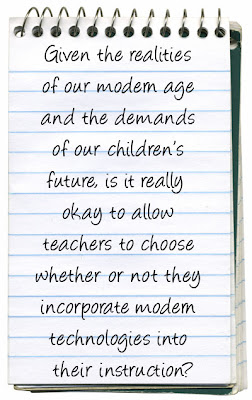For instance-- for those in my local area-- I did not see this in the local news papers, but I did catch it on ASCD's SmartBrief (2/3 of the way down Successful Charter School...)-- KIPP's Harbor Academy in Annapolis will shut down next year. Not because they haven't been successful, but because they can't find space. This considering that Annapolis Middle School is half empty, but won't share space with the successful KIPP program.... very interesting. Honestly, I'm sad to see one of the 2 county charter schools close. It's definitely very, very difficult to be a charter school in AA County and in Maryland. With hopes of one day opening a school of some type, it's sad to see a successful model close its doors.
As for the rest of these links.... I'm closing out the browser windows and linking to articles that catch my attention!
- Cool article about a technology camp in New Orleans. My favorite quote: "Our district puts the money and the technology into students' hands," Charles said. "That's what this camp is all about."
- Another cool quote from an interesting article about SMART boards and Promethean boards (seems the term SMART dominates even when referring to other company's products!): "It is this integration of technology into classrooms that is "really changing the classroom culture and helping us to become better educators," Cleveland Stewart, superintendent of the Gateway School District, told a group of district board members and elected officials last Friday." Check that out again--- technology integration is changing classroom culture and making teachers better. It's SO true. Even better--- those words came from a Superintendent! A little further down, another good quote, "Much of what we have incorporated into the classrooms is nothing new to many of our students. They already use much of what we're now just bringing into the classroom," Ms. Teaters said."
- Educators aren't the only ones trying to tap into our students' technology tendencies.... Doctors are now using technology to reach / teach kids also!
"Physicians and nurses at Cook Children's Medical Center are urging youngsters to try a shoot-'em-up computer game called Re-Mission that teaches them about their disease and pushes them to keep up with treatments.
Re-Mission is just one example of an emerging spate of so-called "serious games" that blend technology, entertainment and education to reach the so-called Xbox generation."
The article discusses other potential uses for these 'serious' video games, including awareness games related to healthy living and childhood obesity. - Another fascinating article about San Diego rolling out a 1-to-1 initiative using custom laptops running Linux.
It starts with a great goal: "Always-On is split into three phases, and SDUSD is in the middle of the first phase, which began in March. The project's goal is to give students access to laptop computers with software tools and resources to help prepare them to learn, live, and work in the 21st century."
Here's how it's working now: Phase I of the pilot, which began in March, used $300,000 to fund machines in nine elementary, middle, and high school classrooms. Each teacher has his or her own set of laptops; some have the same students all day long, and others rotate students, so the students who go to that specific teacher's classroom have access to the laptops."
- Now if this article summary doesn't grab you, I'm not sure what will!
East Chicago, Michigan City, Switzerland County, and Tell City share more than a common Hoosier heritage: They--along with more than 70 other Indiana high schools--are using inexpensive computers and open-source software to reinvigorate teachers, engage learners, and ensure that Indiana's students are prepared for the world of tomorrow.
Great quote about kids today: "When asked if the Linux operating system and open-source software had hampered his productivity in any way, one student said, "It's mostly the same--the web is the same, the word processor is better than what I have used before, and Moodle is great. I have a Windows computer at home, and my friend has a Mac. I use Nintendos, Xboxes, and PlayStations, and I also use my cell phone, my sister's cell, and my friend's. They are all just a little different, but it is no big deal. It's just nice having access to computers in my classrooms." It's clear that today's students are routinely involved with multiple operating systems and software as a regular part of their lives.
The results?? It's working!
"I have never seen this degree of collaboration and excitement among teachers in all my years as a superintendent. The students are excited, too. It works," says John Williams, superintendent of the Rush County Schools.
"These are not computer labs. The technology is in my classroom. Every student has access [to a computer] every period of the day. The computers are available on demand," says Carla Beard, English department chair at Connersville High School. "Not only do we use a variety of software packages, we also have full access to the internet and all of its resources. inACCESS is making a positive difference in learning. Students are engaged and feel more comfortable with rigorous research on more complex topics. This is what they are used to and how they have learned to work."
I think that just about sums it up! If only we could get all schools and students to that point. Access to technology is critical. It's exciting to see progress in that direction and to read positive reports about successful programs!















